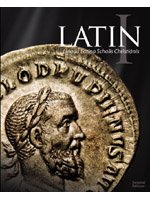BJU Press has taken quite a different approach than other Latin programs. This single text covers much of what is found in both first and second year courses: five declensions of nouns, four conjugations of verbs, plus comparable other grammatical coverage. It uses an unusual inductive approach. Conversations between teacher and students are scripted; they should be read aloud with teacher and one or more students taking parts unless a student is studying alone. Solitary students must read through these conversations on their own—they are essential to the lessons. Conversations are structured to lead students into a grasp of concepts through examination of usage. Most of the time, the teacher in the conversations clarifies or restates the concept the student has just encountered and examined. Information is sometimes presented in isolated boxes for emphasis.
The course is very heavily grammatical in content. It assumes that the student already has a solid grasp of English grammar since it uses such terminology from the very first lesson on. Instead of presenting declensions and conjugation in the traditional chart form, different forms are taught within the context of their functions. The same Latin grammar is eventually covered as in traditional courses but in a very different order. (The traditional charts as well as Latin-English and English-Latin glossaries are at the back of the book for reference.)
More background on language development, history (e.g., the Punic Wars, Julius Caesar, the Roman Republic, and Roman deities), correlations to English and other languages is built into this course from the very beginning lessons than in most courses. Even in the first lesson, students are reading Latin sentences. As they progress, they are given excerpts to read from historical writings and from Latin translations of the Bible.
The Activities Manual is essential to the course. Practice exercises in the Activities Manual link with textbook chapters, providing necessary practice. The text directs students when to do each activity. The text features a well-designed appendix for grammar concepts for easy reference plus both English-Latin and Latin-English glossaries.
This course requires a more thoughtful approach than do those that present information for students to memorize. In some ways it is more confusing—many new concepts to learn in the very first lesson, but it does strive to quickly give students a more immediate experience with hearing and speaking the language than do programs that begin with memorizing declensions and vocabulary.
Classical Latin pronunciation is used rather than ecclesiastical pronunciation. The teacher's edition includes a CD that helps with pronunciation. This is primarily for the parent/teacher to master pronunciation, but students might also use it. Pronunciation instructions are in the text, so use of the pronunciation CD is optional.
Important instructional elements are contained in the teacher's edition along with answers and suggested translations. (Note that some activities and translations are presented within the student text.) Most written exercises are in the Activities Manual. You will need the separate teacher's edition that goes with the Activities Manual as an answer key. A separate test packet is also available.
I would caution students who have not mastered English grammar to remedy that deficit before tackling this course.
Latin II reviews content from Latin I, then adds more complex, irregular, or unusual grammatical topics such as the vocative and locative cases for nouns, the subjunctive mood for verbs, verbals, deponent verbs, and irregular adjectives. Students practice quite a bit of translation. As with Latin I, this is a challenging course that really requires a teacher. No activity book is available for the second year.








